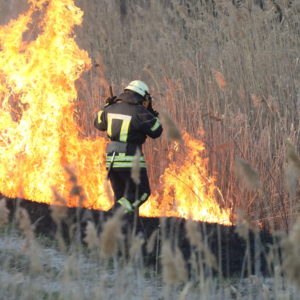Mere hours before the government shutdown began last month, President Trump slipped through an executive order on forest management that will leave communities and forests vulnerable to future wildfires.
Just months after some of the most catastrophic fires in this nation’s history, the president’s action undercuts bedrock environmental laws and significantly increases the amount of timber — by almost one billion board-feet, more than 30 percent above recent levels — that should be logged in national forests each year.
To support this effort, the administration has created a bogeyman of “radical environmentalists,” which both willfully ignores and distracts from the real contributors to wildfires: climate change and the growing wildland-urban interface.
Instead of tackling the real issues, Trump has advanced an industry-friendly solution — more logging — but this action simply isn’t supported by science. In fact, research suggests that logging alone — and especially managing forests for intensive timber production — does little to slow wildfire, and in some situations, can make wildfires stronger.
The president’s order compels the U.S. Forest Service to create new environmental waivers for logging projects — essentially allowing them to bypass scrutiny about their potential impacts to land, water and wildlife. This proposal mirrors one included in the failed House version of the Farm Bill, which was wisely rejected by the Senate before the bill became law. In essence, this executive order is the Trump administration’s end run around the wishes of Congress when it comes to management of our public lands.
The data do not support the administration’s messaging that environmental reviews (or legal challenges to them) play a significant role in slowing timelines for “hazardous fuels” projects that are meant to reduce the risk of the most dangerous fires. A 2010 GAO report found that litigation occurred in only 2 percent of projects and affected less than 121,000 acres of the 9 million that were under review.
In addition, the Forest Service has hundreds of thousands of acres that have completed environmental review under the National Environmental Policy Act but are still waiting for resources and contracts to get underway.
All the more perplexing, the executive order also emphasizes salvage logging projects, in which companies log dead and burned trees in already-burned areas after a wildfire. These projects are commercially valuable but do little to proactively protect communities or forests from fire, raising more red flags about the administration’s true motivation.
Rather than environmental reviews, the real issue behind any backlog for forest management is resources. In order to address the longer and more costly fire seasons, the Forest Service has had to redirect larger and larger parts of its budget. As a result, the number of non-fire personnel has dropped by nearly 40 percent since 1995, leaving a thin bench of career employees to plan projects and review contracts for things like forest restoration and prescribed burns that reduce the risk of catastrophic fire.
Meanwhile, on the same day the executive order was issued, the federal government shut down. With seemingly no end in sight, state and federal agencies that would be hiring and training firefighters for the 2019 wildfire season are now faced with the possibility of running out of federal funds that keep this critical public safety process in motion. If wildland firefighter classes are delayed and paperwork is halted, it will become harder to mobilize resources when communities need them.
If we really want to protect our communities, the solutions need to match the problems. Last year’s fire fix is an important start, giving more resources to the Forest Service to do the “ounce of prevention” work. Protecting communities in fire-prone landscapes (which is most of the country) also means preparing houses and buildings to be less vulnerable to burning embers and creating defensible spaces in neighborhoods.
And, as a major land owner in many parts of the West, federal land agencies should work with states and communities to transparently plan and prioritize restoration that provides clear public benefits in the face of a changing climate.
Wildfires have always been present on the landscape, especially in the West, and the combined effects of climate change and more people living in wildlands mean that we need better plans and policies to protect our communities during longer, more active fire seasons. But the administration’s push for higher timber targets and environmental review shortcuts — combined with its ill-timed government shutdown — offer little in the way of measurable safety gains. If we want to truly protect communities, we need to invest in them at the ground level, not create loopholes that provide no public accountability for safeguarding homes and lives.

